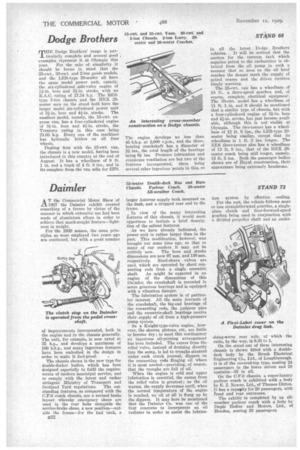Daimler
Page 160

If you've noticed an error in this article please click here to report it so we can fix it.
AT the Commercial Motor Show of 1927 the Daimler exhibit created something of a furore by virtue of the manner in -which extensive use had been made of aluminium alloys in order to achieve that much-sought feature—lightness in weight.
For the 1930 season the same principles as were employed two years .ago are continued, but with a great number
of improvements incorporated, both in the engine and in the chassis generally. The unit, for example, is now rated at 85 h.p., and develops a maximum of 100 b.h.p., and many ingenious features have been embodied in the design in order to make it fool-proof.
The chassis shown is the new type for double-decker bodies, which has been designed especially to fulfil the requirements of modern municipal service, and to comply with the latest and rather stringent Ministry of Transport and
1::cotland Yard regulations. The outstanding features, as compared with the C.F.6 coach chassis, are a revised brake layout whereby emergency shoes are used in the rear hubs alongside the service-brake shoes, a new position—outside the frame—for the fuel tank, a
R22 larger Autavac supply tank mounted on the dash, and a dropped rear end to the frame.
In view of the many interesting ieatures of this chassis, it would seem opportune to include a brief description of the salient features.
As we have already indicated, the power unit is rather larger than in the past. This modification, however, was brought out some time ago, so that to many of our readers it may not be
entirely new. The bore and stroke dimensions are now 97 inm. and 130 mm. respectively. Steel-sleeve valves are used, which are operated by short connecting rods from a single eccentric
shaft. As might be expected in an engine of the dimensions of this Da:mler, the crankshaft is mounted in seven generous bearings and is equipped with a vibration damper.
The lubrication system is of particular interest. All the main journals of the crankshaft, the big-end bearings of the connecting rods, the gudgeon pins and the eccentric-shaft bearings receive their supply of oil from a high-pressure pump system.
In a Knight-type-valve engine, however, the sleeves, pistons, etc., are liable to become dry ; to meet this contingency an ingenious oil-priming arrangement has been included. The excess from the relief valve, instead of draining directly into the sump, is led to troughs situated under each crank journal, dippers on the connecting rods flinging oil where it is most needed—providing, of course, that the troughs are full of oil.
When the engine is cold and upper lubrication is essential, the excess from the relief valve is greatest ; as the oil warms, the supply decreases until, when the normal temperature of the engine is reached, no oil at all is flung up by the dippers. It may here be mentioned that the Daimler Co. was one of the first concerns to incorporate an oil radiator in order to assist the lubriea tion system by effective cooling.
For the rest, the vehicle follows more or less straightforward practice, a singleplate clutch and four-forward-speed gearbox being used in conjunction with a divided propeller shaft and an under slung-worm rear axle, of which the ratio, by the way, is 8.2.5 to 1.
On the stand one of these interesting chassis is shown fitted with a doubledeck body by the Brush Electrical Engineering Co., Ltd., of Loughborough. It is of the covered-top type, seating 24 passengers in the lower saloon and 28 upstairs-52 in all.
On the C.F.0 chassis, a super-luxury parlour coach is exhibited with a body by E. 3'. Newns, Ltd., of Thames Ditton. It has a capacity for 20 passengers, with front and rear entrances. • The exhibit is completed by an allweather parlour coach with a body by Duple Bodies and Motors, Ltd., of Hendon, seating 28 passengers:








































































































































































































































































































































